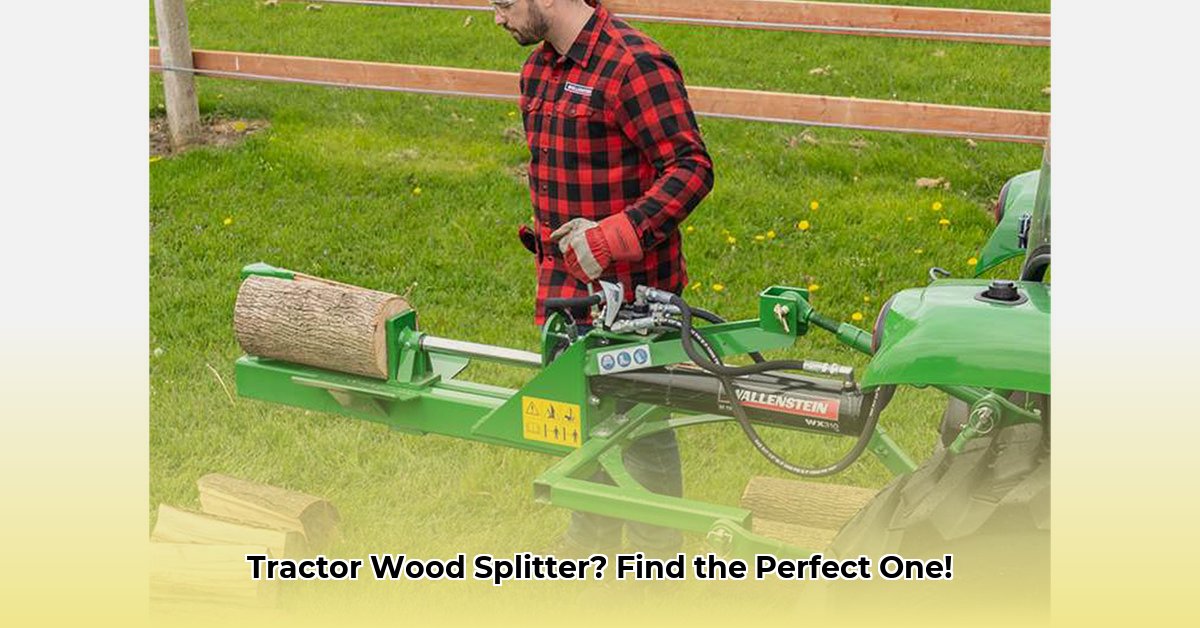
Splitting wood by hand is hard work. But what if you could harness your tractor's power for easier, faster splitting? This guide helps you choose the right hydraulic wood splitter, whether you're a seasoned farmer or a weekend woodcutter. We'll compare 3-point hitch and PTO models, guiding you through installation and maintenance. Let's get started! For more information on tractor-mounted splitters, check out this helpful resource: Tractor Wood Splitters.
Understanding Your Tractor's Hydraulic System: The Power Source
Before choosing a splitter, understand your tractor's hydraulics. This system powers the splitter; its capacity is crucial. The key is gallons per minute (GPM), indicating the hydraulic fluid volume pumped per minute. Higher GPM means faster splitting. Find this information in your tractor's manual; it's usually in the hydraulic specifications section. A low GPM will limit a high-demand splitter, resulting in slow work. Think of it like using a tiny hose to water a large garden – it'll work, but slowly.
3-Point Hitch Splitters: Simple and Integrated
These splitters connect directly to your tractor's three-point hitch, simplifying installation. The tractor's hydraulics power the splitter's ram, pushing the wedge through the wood. It's a direct power connection.
Pros:
- Easy installation: Typically a simple connection.
- Direct power transfer: No extra pumps or complex systems.
- Lower cost: Generally less expensive than PTO models.
Cons:
- Reliance on tractor hydraulics: Performance is limited by your tractor's hydraulic capacity. Low GPM will result in slow splitting speeds. This can significantly increase processing times, impacting overall efficiency.
- Limited by tractor GPM: You can't independently upgrade the splitter's power.
PTO (Power Take-Off) Splitters: Independent Power
PTO splitters have their own hydraulic pump, driven by your tractor's PTO shaft. This independence allows them to work with a wider range of tractors, regardless of GPM.
Pros:
- Wider tractor compatibility: Works well even with tractors having less powerful hydraulic systems. This expands your options greatly.
- Higher splitting power: Typically offers greater capacity for splitting larger logs quickly. This can dramatically increase output.
Cons:
- More complex setup: Installation requires more mechanical skill.
- Higher initial cost: The added pump and components increase the price compared to 3-point hitch models.
- Increased maintenance: More parts to maintain and potentially repair.
Choosing the Right Splitter: A Decision Matrix
Choosing the right wood splitter depends on several factors. Use this decision matrix for guidance:
| Factor | 3-Point Hitch | PTO |
|---|---|---|
| Tractor Hydraulics | Requires sufficient GPM; low GPM limits speed | Less dependent on tractor GPM; suitable for lower capacity tractors |
| Initial Cost | Generally lower | Generally higher |
| Installation | Simple and straightforward | More complex, may require mechanical skills |
| Maintenance | Relatively simple | More complex and potentially costly |
| Best Suited For: | Smaller jobs, tractors with high GPM | Larger jobs, tractors with lower GPM or high splitting demands |
Safety, Maintenance, and Accessories: Essential Considerations
Safety and maintenance are paramount. Always consult your splitter's manual for specific instructions and precautions.
- Wear appropriate safety gear: Safety glasses, gloves, and sturdy footwear are essential.
- Regularly inspect and lubricate: Check fluid levels, hydraulic connections, and moving parts.
- Consider accessories: A four-way wedge enhances versatility.
Next Steps: Research and Selection
Now you're ready to research specific models. Consider your tractor's capabilities, budget, and the size of wood you'll split. Compare specifications and features, and don't hesitate to seek advice from experienced users or equipment dealers. Choosing the right splitter enhances efficiency and enjoyment. The best choice depends on your unique needs and priorities.